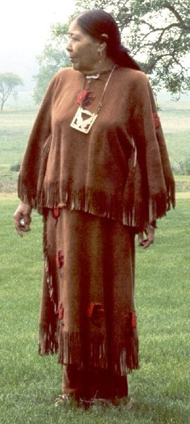Delaware Tribe of Indians

The Delaware Tribe of Indians, formerly known as the Cherokee Delaware or the Eastern Delaware, based in
.Government and economic development
The Principal Chief is Brad KillsCrow. The Assistant Chief is Tonya Anna.[2] They are headquartered in Bartlesville and have no tribal jurisdictional area. Their housing program covers Washington, Nowata, Rogers, Craig, and part of Tulsa counties. Their annual tribal economic impact is $2 million.[3]
Enrollment
Tribal membership is limited exclusively to descendants of Delaware people on the 1906 tribal rolls from
Culture
The Council of Lenape Elders works to sustain traditional dances, culture, and the tribal language, and works with the Delaware Gourd Society. The tribe maintains a Delaware Center, on an 80-acre (320,000 m2) parcel of land in Bartlesville.[5] Delaware artists are known for their wood carving and ribbon work skills.
History
The historically
The Delaware nation was the first to sign a treaty with the new
Traditionally the Delaware were divided into the Munsee, Unami, and Unalachtigo, three social divisions determined by language and location.[6]
Federal recognition

First recognition
After dealing with the United States on a government-to-domestic dependent nation basis, the ancestors of the Delaware Tribe of Indians agreed in 1867 to
Following passage of the 1972 Appropriations Act, the
Second recognition
The Delaware Tribe of Indians regained their federal recognition by the Secretary of the Interior in 1991, when the BIA rescinded its 1979 decision. However, the Cherokee Nation disagreed with the decision and filed suit against the BIA and the Secretary of their decision. The Cherokee Nation's position was upheld in court, leading to the Delaware Tribe's loss of federal recognition in 2004.[1] After years of negotiations, the two tribes resolved their differences through an agreement in October 2008. Delaware voters approved the agreement and voted to reorganize in May 2009, under the authority of the Oklahoma Indian Welfare Act.
Third recognition
On July 28, 2009, The United States Department of the Interior notified the tribal office in Bartlesville that the Delaware are again officially recognized by the U.S. government.[7]
Notable tribal members
- Touching Leaves Woman, 1907–1984), traditionalist, herbalist, and language instructor
- Charles Journeycake (Ne-Sha-Pa-Na-Cumin, December 16, 1817 - January 3, 1894) - In 1861, Journeycake became the principal Chief of the Delaware tribe.
- Joanne Barker, professor, author
Notes
- ^ a b Delaware Tribe regains federal recognition. Archived March 19, 2016, at the Wayback Machine NewsOk. 4 Aug 2009 (retrieved 5 August 2009)
- ^ "Official Site of the Delaware Tribe of Indians » Delaware Tribal Council". delawaretribe.org. Retrieved February 7, 2022.
- ^ a b 2011 Oklahoma Indian Nations Pocket Pictorial Directory. Archived May 12, 2012, at the Wayback Machine Oklahoma Indian Affairs Commission. 2011: 13. Retrieved 3 Jan 2012.
- ^ a b c Delaware Tribe of Indians. Archived 2011-11-02 at the Wayback Machine (retrieved 5 August 2009)
- ^ Frenchman, Titus. Federal Recognition Weeks Away for Delaware Tribe. Native American Times. (retrieved 5 Aug 2009)
- ^ McCollum, Timothy James. Delaware, Western. Archived 2008-12-24 at the Wayback Machine Oklahoma Historical Society's Encyclopedia of Oklahoma History & Culture. (retrieved 5 August 2009)
- ^ Delaware Tribe of Indians’ federal recognition restored. Indian Country Today. 7 Aug 2009 (retrieved 11 August 2009)
External links
- Delaware Tribe of Indians, official website
- Eastern Delaware Archived February 6, 2012, at the Wayback Machine, Oklahoma Historical Society's Encyclopedia of Oklahoma History and Culture
